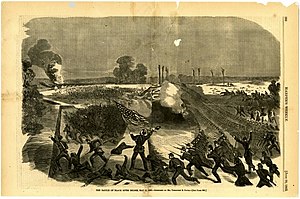
Back Slaget ved Big Black River Bridge Danish Bataille de Big Black River Bridge French קרב גשר נהר ביג בלאק HE Battaglia di Big Black River Bridge Italian Slag bij Big Black River Bridge Dutch Сражение при Биг-Блэк-Ривер-Бридж Russian Trận cầu sông Big Black Vietnamese 大黑河橋之戰 Chinese
| Battle of Big Black River Bridge | |||||||
|---|---|---|---|---|---|---|---|
| Part of the American Civil War | |||||||
 The Battle of Big Black River Bridge, Harper's Weekly, June 20, 1863, issue | |||||||
| |||||||
| Belligerents | |||||||
| United States | Confederate States | ||||||
| Commanders and leaders | |||||||
| John McClernand |
John Bowen John Vaughn | ||||||
| Units involved | |||||||
| XIII Army Corps |
Bowen's division Vaughn's brigade | ||||||
Location within Mississippi | |||||||
The Battle of Big Black River Bridge was fought on May 17, 1863, as part of the Vicksburg Campaign of the American Civil War. During the war, the city of Vicksburg, Mississippi, was a key point on the Mississippi River. On April 30, 1863, a Union army commanded by Major General Ulysses S. Grant began crossing onto the east side of the Mississippi River as part of a campaign against Vicksburg. After engaging and defeating Confederate forces in several intermediate battles, Grant's army defeated Lieutenant General John C. Pemberton's Confederates at the decisive Battle of Champion Hill on May 16. During the retreat from Champion Hill, one division of Pemberton's army, commanded by Major General William W. Loring, was cut off from Pemberton's main body. Pemberton did not know the location of Loring's division, and he held a bridgehead on the east side of the Big Black River to cover Loring's anticipated withdrawal across the river on the morning of May 17.
The Confederate force east of the Big Black River was commanded by Brigadier General John S. Bowen and consisted of the two brigades of his division, the brigade of Brigadier General John C. Vaughn, and one additional regiment. Bowen's men had taken heavy casualties at Champion Hill, and most of Vaughn's men were conscripts of uncertain loyalty. On the morning of May 17, the Union XIII Corps commanded by Major General John A. McClernand approached the Confederate position. Two divisions and another brigade from a third deployed to face the Confederates. Union Brigadier General Michael Kelly Lawler advanced his troops into an old meander scar in advance of the main Union line on the north end of the battlefield. From this sheltered position, Lawler's men charged, striking the Confederate line in the region held by Vaughn's brigade.
Vaughn's troops broke, with the men either running away or surrendering. The collapse of this portion of the Confederate line forced the troops on either side to withdraw. The withdrawal became chaotic and 1,751 Confederate soldiers and 18 cannons were captured. The cannons were captured because their teams of horses were erroneously positioned on the other side of the Big Black River. Fewer than 300 Union soldiers became casualties. The retreating Confederates burned both the railroad bridge over the Big Black River and a steamboat that had been serving as a bridge. Loring had already given up on rejoining his division to Pemberton's army and his troops marched to Jackson, Mississippi. On May 18, the Union army crossed the Big Black River. The surviving Confederate soldiers entered the fortifications at Vicksburg, and the siege of Vicksburg began the next day; it ended in the Confederate surrender on July 4, 1863.
- ^ Kennedy 1998, p. 170.
© MMXXIII Rich X Search. We shall prevail. All rights reserved. Rich X Search
